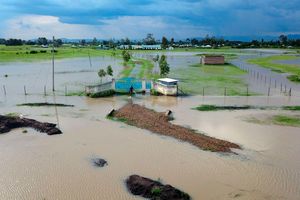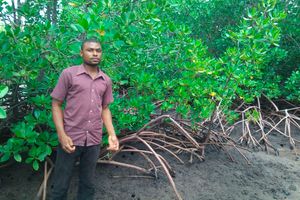Lake Ol’ Bolossat slowly springing back to life

Lake Ol’ Bolossat in Nyandarua County.
What you need to know:
- The lake water levels have now risen to 25 percent, thanks to the seasonal short rains that have brought a sigh of relief to residents.
- The restoration process to reclaim the lake's land and shield it from grabbers and farming activities has gathered momentum through the planting of trees.
Efforts by Nyandarua residents and the county government to revive Lake Olbolossat are slowly paying off. The once 43-square-kilometre lake was on its death bed, leading to conflicts between locals and hundreds of herders from Baringo, Laikipia and Samburu counties who occupied the dry lake land.
The lake water levels have now risen to 25 percent, thanks to the seasonal short rains that have brought a sigh of relief to residents. The restoration process to reclaim the lake's land and shield it from grabbers and farming activities has gathered momentum through the planting of trees.
The implementation of the 2020-2030 Integrated Management Plan at an estimated Sh20 billion - , a strategic plan developed by the county government and development partners - will also restore the lake's beauty and improve the livelihoods of the locals.
The lake provides water for irrigation, supports fishing activities and is a source of tourism revenue. “We’re optimistic the lake will regain its lost glory. As a community, we fully support the initiatives to restore the lost glory of the lake. Our poor farming practices and the cutting of trees have led to massive soil erosion into the lake,” said Paul Kung’u, a resident.

He added: “The restoration of the lake will lead to more local and international tourists and this will translate to more revenue generation for the residents and the county government.” Mr James Njoroge, a resident said: “With the ongoing restoration and community ownership of the lake as well as the anticipated El nino rains, the lake will be vibrant once again in three years if the restoration pace is maintained.”
Mr Mwanzia Kyambia, the county climate change director, said the weed in the lake are a new emerging challenge in the restoration of the wetland. “The weed is a big threat because once it dies, it will lead to sedimentation of the lake,” said Mr Kyambia. The director also attributed the 25 per cent restoration to some water catchment areas and streams feeding the lake.
“We have successfully reclaimed and engaged the communities around the streams that drain into the lake on the need to conserve the streams and sources at the Aberdare Forest,” said Mr Kyambia. Nyandarua Governor Kiarie Badilisha noted that another challenge facing the lake is the recovery of lake land, which is in private hands.
“Some land owners have documents, and this has made funding the work plan complicated,” said Governor Badilisha. “We have engaged the National Lands Commission for demarcation of the lake and its land to its original boundaries. Those with genuine title deeds will be compensated but otherwise, everyone will have to vacate the lake's land.”
“This is a very important natural resource for Nyandarua, Kenya and internationally. It must be restored and conserved at whatever cost. I am happy that the national government is fully committed to the restoration, preservation and conservation of the water body with its wetlands,” said the governor.
In July this year, in a consultative meeting at the governor’s office, it was agreed that reclaiming Lake Olbolossat under the Wetland Restoration Programme be a joint initiative of the national and county governments.
The forum was attended by the principal secretaries of Environment Festus Ng’eno and Gitonga Mugambi (Forestry) among other parties, where it was resolved that the lake’s restoration programme takes several multi-sectoral strategies. Top on the agenda was to ensure a sustainable land use management policy is implemented.
“Reclaiming Lake Olbolossat has far-reaching environmental and economic benefits that go beyond Nyandarua County. The strategy should ensure that local populations benefit from the asset and own its restoration for sustainability. Encroachment must be stopped by securing and fencing the lake. The ecosystem has the potential to be a national trees’ nursery; creating employment for thousands of residents,” said the governor.
He said among the priorities of his government was seeking partnerships with other development partners. “We want partnerships that will give the lake a new hope, with a promising future.” The first step was enactment of the Nyandarua County Climate Change Act, 2021 forming a framework and mechanism to effectively respond to climate change through appropriate locally-led climate actions within the county.
According to the governor, the Act provided the mechanisms and measures to improve resilience to climate change and promote low-carbon development. The Act adopts a mainstreaming approach, providing a legal basis for climate change activities.
Mr Wachira Mugo, the Water and Climate Change Executive, said the Act provided for the establishment of the County Climate Change Unit responsible for mainstreaming county climate change actions and the establishment of a steering committee composed of county executive members.
The Unit also comprised 25 ward committees and a boost of the County Climate Change Fund of two per cent allocation of the county development budget. Njeri Njoroge, the Climate Change Chief Officer, said part of the Integrated Management Plan being implemented is the promotion of sustainable ecologically friendly livelihood activities that have motivated community ownership of the lake and its restoration efforts.
“Under the restoration project, we are promoting fruit trees growing as an alternative income-generating activity through agroforestry. This will improve the livelihoods of 4,000 households by growing 80,000 fruit trees. We have partnered with the Nature Conservancy through which we are planting more than 1.3 million around the lake’s catchment area under an initiative Adopt a Tree involving the farmers and learners in schools neighbouring the lake,” said Ms Njoroge.
Motivated by the government and community restoration efforts, many donors are supporting the initiative. Lake Ol’ Bolossat is an important bird and biodiversity area that includes hippos and over 300 bird species (both residents and migrants) and is the only lake in central Kenya.
The lake forms the headwaters for the Ewaso Nyiro River, which supports the livelihoods of communities, livestock and wildlife in the dry Laikipia, Samburu, Isiolo and Garissa counties.
The lake lies within the central tourism circuit and is one of the sources that supply Nyahururu town with water. The Ewaso Nyiro River supports the thriving wildlife tourism in Buffalo Springs, Shaba National Reserve and Lorian swamp in Wajir, where the rivergoes underground, to re-emerge in Somalia where it joins the Jubba River.




